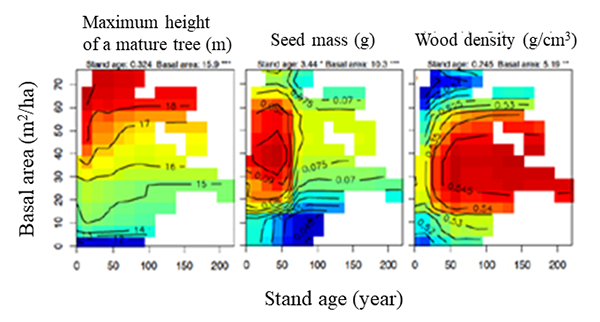Home > Research > Research Results > Research Results 2017 > Changes in the functional composition of tree communities along successional gradients after land-use change across Japan
Update:August 10, 2017
Main content starts here.
Changes in the functional composition of tree communities along successional gradients after land-use change across Japan
| Article title |
Context-dependent changes in the functional composition of tree communities along successional gradients after land-use change |
|---|---|
| Author (affiliation) |
Masahiro Aiba (a), Hiroko Kurokawa (b), Yusuke Onoda (c), Michio Oguro (a), Tohru Nakashizuka (a), Takashi Masaki (b) (a) Tohoku University, Sendai, Miyagi, Japan. (b) Department of Forest Vegetation, FFPRI, Tsukuba, Ibaraki, Japan. (c) Kyoto University, Kyoto, Japan. |
| Publication Journal |
Journal of Ecology, 104(5):1347-1356, September 2016, DOI: 10.1111/1365-2745.12597( External link ) |
| Content introduction |
The Forestry Agency has been conducting a National Forest Inventory in Japan since 1999 to determine forest resources in approximately 14,000 tree communities in forest plots across Japan. For this study, data on the stand age after logging as well as species identity and sizes of every tree in each community were extracted from 2,574 of these 14,000 plots. Moreover, the maximum height of mature trees, sizes of leaves, leaf mass per unit area, wood density, and weight of seeds were measured for approximately 200 major species in Japan and analyzed with forestry data described above. The results showed that tree species with a relatively low maximum height, large leaves, a low leaf mass per unit area, a low wood density, and a low seed mass tended to dominate in tree communities with a small basal area (an index of the amount of trees) nationwide regardless of the stand age. This indicated that the pioneer species with these characteristics, which invade and rapidly grow in vacant spaces after logging, increased in such communities. Such changes in the tree communities due to logging possibly reduce the forest ecosystem functions, including its capacity to store carbon. On the other hand, changes in tree communities associated with the invasion of species that form a canopy layer lead to recovery in the forest ecosystem function. However, time required to achieve these changes varied depending on the type of the forest. Continuous nationwide monitoring of forests hereafter is necessary for adequate forest management, including the prediction of such changes, throughout Japan, although prediction of the shifts in the forest ecosystem after logging is not an easy task.
Figure. Changes in the functional composition of tree communities along with stand age and basal area (in case of a warm-temperate forest). In each figure, the warmer color indicates larger values. In forests with small basal area (black-bordered), tree species with low maximum height, light seed weight, and low wood density tend to dominate.
|
Copyright © Forest Research and Management Organization. All rights reserved.

